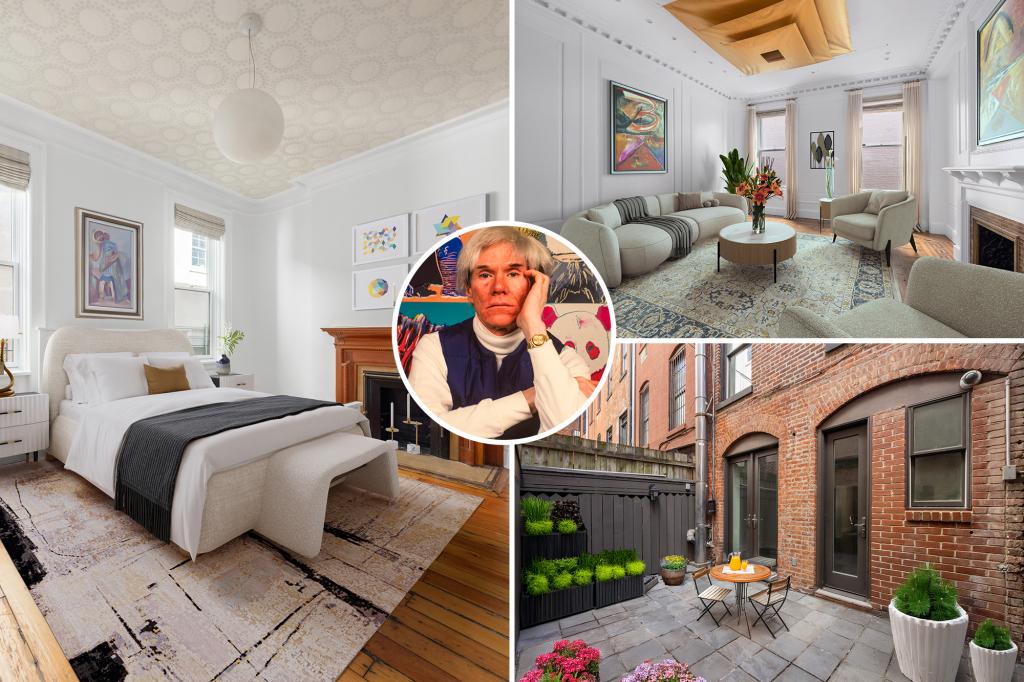Home is where the art is.
The Manhattan townhouse formerly owned by pop art titan Andy Warhol will list on Thursday for $6.95 million, marking its first sale in more than a decade, The Post has learned. And it still retains quirky traces of Warhol’s residency.
This Upper East Side dwelling, at 1342 Lexington Ave., last changed hands in 2013 for $5.5 million and briefly appeared as a rental in December for $22,550 a month.
The current owners, who have held the property as an investment, never called it their own home.
Instead, they leased it out over the years, said Loy Carlos, the broker representing the sale through Nest Seekers International’s Global Wealth Office.
“They’re just ready to move on,” Carlos said. “They really liked the provenance of the house. I think they were very excited when they bought it … at this point they just sort of want to divest some properties.”
Warhol’s imprint on the 19th-century townhouse, designed by architectural luminary Henry J. Hardenbergh — whose portfolio includes the Plaza Hotel and the Dakota — is unmistakable.
From 1960 to 1972, this narrow, 3,072-square-foot abode served as both residence and studio, where the artist produced some of his most iconic works — including the “Campbell’s Soup Cans” and portraits of cultural giants like Muhammad Ali and Marilyn Monroe.
“He lived there at a time when he was most productive and a lot of his works that we know, and are well known around the world, were actually done in this house,” Carlos said.
Traces of Warhol’s era linger in whimsical details: a front door handle fashioned partly from one of his walking sticks, plus a kitchen floor streaked with green paint, a remnant of the garden-level space he used as a studio.
“This is where he got his creative juices flowing and made art that funded the lifestyle he had for the rest of his life,” Merav Shalhon of Essential New York Real Estate, previously told The Post. Shalhon noted Warhol shared the home with his mother, who famously picked up those legendary soup cans from a grocery store — now a Gristedes — across the street. “It’s always been a grocery store in one form or another,” she added.
Built in the 1880s, the four-bedroom, 4.5-bathroom prewar home reflects a bygone era’s charm.
Carlos sees it as a fitting parallel to Warhol’s aesthetic.
“I was thinking about Andy Warhol and how his work was what it was. It wasn’t, you know, pretending to be something else. It was taking something that’s relatively simple. And what seems ordinary and somehow coaxing the glamor out of it,” he said. “This is that kind of house. It has all of the beautiful elements architecturally. The spaces are correct. The layout is correct. You have a nice feel of the home.”
The townhouse’s recent renovation blends modern comforts with its historic bones. A parlor-level foyer opens to a wood-paneled library and a living room with a woodburning fireplace, while upstairs bedrooms — two with fireplaces — offer ensuite baths and custom closets.
The listing highlights a “bright windowed breakfast kitchen” with top-tier appliances and a den overlooking a rear patio.
Zoned for live/work use, the property could transform into an art gallery or office, with dual entrances enhancing its versatility.
For Carlos, the home’s value transcends its walls, enriching Carnegie Hill’s tapestry of architectural treasures.
“With these homes on Lex, Fifth Avenue and Park Avenue, etcetera, we’re looking at all of the big houses, and we look at them like gigantic gems that are beautiful and coveted and for very good reason,” he said.
“But I think what we forget in the context of jewelry. When you have a beautiful gem, if you put all of these other smaller jewelry … smaller diamonds around it, it sparkles. It makes it look better.”
Andy Warhol left the home in 1972, 15 years before his death at age 58 following complications from a gallbladder surgery. It had been his for 15 years. In 1974, after sitting vacant for two years, Warhol rented it to his longtime business manager and friend Frederick Hughes, who was also ultimately the executor of Warhol’s estate.
A year after Warhol died, Hughes bought the property from the estate for $593,500 and stayed there until his own death in 2001. Upon Hughes’ death, his sister sold the residence.
Today, a private family trust owns the residence, and about 150 cats — descendants of Warhol’s feline companions — still roam the backyard, Shalhon said.
“It doesn’t seem so far removed from the history and the past than the newer larger buildings devoid of architecture and history,” Carlos said.
“It feels rather very gracious and charming. And it almost feels to me like if you close your eyes, you could almost visualize Carnegie Hill where there was a time when kids still played outside.”
